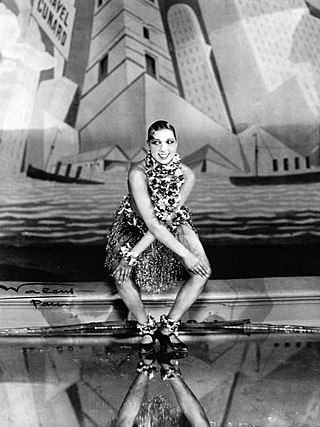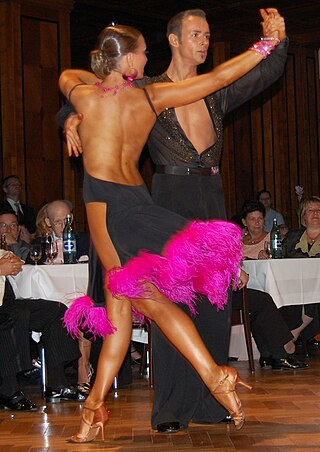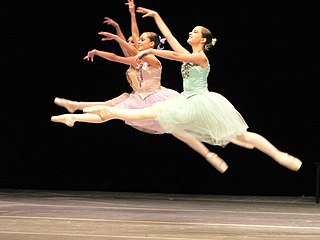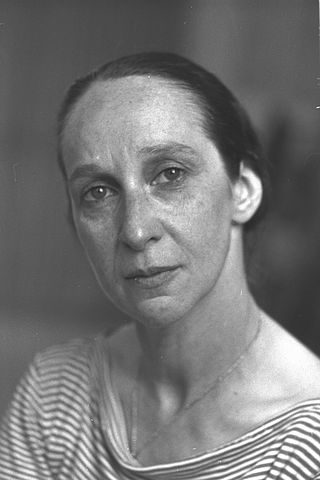Related Research Articles
In partner dancing, connection is a term that refers to physical, non-verbal communication between dancers to facilitate synchronized or coordinated dance movements. Some forms of connection involve "lead/follow" in which one dancer directs the movements of the other dancer by means of non-verbal directions conveyed through a physical connection between the dancers. In other forms, connection involves multiple dancers without a distinct leader or follower. Connection refers to a host of different techniques in many types of partner dancing, especially those that feature significant physical contact between the dancers, including the Argentine Tango, Lindy Hop, Balboa, East Coast Swing, West Coast Swing, Salsa, and other ballroom dances.
Jazz dance is a performance dance and style that arose in the United States in the mid 20th century. Jazz dance may allude to vernacular jazz about to Broadway or dramatic jazz. The two types expand on African American vernacular styles of dance that arose with jazz music. Vernacular jazz dance incorporates ragtime moves, Charleston, Lindy hop and mambo. Popular vernacular jazz dance performers include The Whitman Sisters, Florence Mills, Ethel Waters, Al Minns and Leon James, Frankie Manning, Norma Miller, Dawn Hampton, and Katherine Dunham. Dramatic jazz dance performed on the show stage was promoted by Jack Cole, Bob Fosse, Eugene Louis Faccuito, and Gus Giordano.

The performing arts are arts such as music, dance, and drama which are performed for an audience. They are different from the visual arts, which are the use of paint, canvas or various materials to create physical or static art objects. Performing arts include a range of disciplines which are performed in front of a live audience, including theatre, music, and dance.

The Charleston is a dance named after the harbor city of Charleston, South Carolina. The rhythm was popularized in mainstream dance music in the United States by a 1923 tune called "The Charleston" by composer/pianist James P. Johnson, which originated in the Broadway show Runnin' Wild and became one of the most popular hits of the decade. Runnin' Wild ran from 28 October 1923, through 28 June 1924. The peak year for the Charleston as a dance by the public was mid-1926 to 1927.

Swing dance is a group of social dances that developed with the swing style of jazz music in the 1920s–1940s, with the origins of each dance predating the popular "swing era". Hundreds of styles of swing dancing were developed; those that have survived beyond that era include Lindy Hop, Balboa, Collegiate Shag, and Charleston. Today, the best-known of these dances is the Lindy Hop, which originated in Harlem in the early 1930s. While the majority of swing dances began in African-American communities as vernacular African-American dances, some influenced swing-era dances, like Balboa, developed outside of these communities.

Choreography is the art or practice of designing sequences of movements of physical bodies in which motion or form or both are specified. Choreography may also refer to the design itself. A choreographer is one who creates choreographies by practising the art of choreography, a process known as choreographing. It most commonly refers to dance choreography.

Partner dances are dances whose basic choreography involves coordinated dancing of two partners, as opposed to individuals dancing alone or individually in a non-coordinated manner, and as opposed to groups of people dancing simultaneously in a coordinated manner.

The history of dance is difficult to access because dance does not often leave behind clearly identifiable physical artifacts that last over millennia, such as stone tools, hunting implements or cave paintings. It is not possible to identify with exact precision when dance becomes part of human culture.Dance is filled with aesthetic values, making it distinct from one society to another and is shrouded in symbolism that expounds on the cultural heritage of a community accordingly being unique from one society to another. Dance can help tell a story, convey feelings and emotions, and connect with others and ourselves.

Contemporary dance is a genre of dance performance that developed during the mid-twentieth century and has since grown to become one of the dominant genres for formally trained dancers throughout the world, with particularly strong popularity in the U.S. and Europe. Although originally informed by and borrowing from classical, modern, and jazz styles, it has come to incorporate elements from many styles of dance. Due to its technical similarities, it is often perceived to be closely related to modern dance, ballet, and other classical concert dance styles.
This is an alphabetical index of articles related to dance.

Concert dance is dance performed for an audience. It is frequently performed in a theatre setting, though this is not a requirement, and it is usually choreographed and performed to set music.
Postmodern dance is a 20th century concert dance form that came into popularity in the early 1960s. While the term "postmodern" took on a different meaning when used to describe dance, the dance form did take inspiration from the ideologies of the wider postmodern movement, which "sought to deflate what it saw as overly pretentious and ultimately self-serving modernist views of art and the artist" and was, more generally, a departure from modernist ideals. Lacking stylistic homogeny, Postmodern dance was discerned mainly by its anti-modern dance sentiments rather than by its dance style. The dance form was a reaction to the compositional and presentational constraints of the preceding generation of modern dance, hailing the use of everyday movement as valid performance art and advocating for unconventional methods of dance composition.
There is great variety in dance in the United States of America. It is the home of the hip hop dance, salsa, swing, tap dance and its derivative Rock and Roll, and modern square dance and one of the major centers for modern dance. There is a variety of social dance and concert or performance dance forms with also a range of traditions of Native American dances.

Anna Sokolow was an American dancer and choreographer known for the social justice focus and theatricality of her work, and for her support of the development of Modern Dance in Mexico and in Israel.

African-American dance has developed within various spaces throughout African-American communities in the United States, rather than studios, schools, or companies. These dances are usually centered on folk and social dance practice, though performance dance often supplies complementary aspects to this. Placing great value on improvisation, these dances are characterized by ongoing change and development. There are a number of notable African-American modern dance companies using African-American cultural dance as an inspiration, among these are the Whitey's Lindy Hoppers, Alvin Ailey American Dance Theater, Dance Theatre of Harlem,and Katherine Dunham Company. Hollywood and Broadway have also provided opportunities for African-American artists to share their work and for the public to support them.

Modern dance is a broad genre of western concert or theatrical dance which included dance styles such as ballet, folk, ethnic, religious, and social dancing; and primarily arose out of Europe and the United States in the late 19th and early 20th centuries. It was considered to have been developed as a rejection of, or rebellion against, classical ballet, and also a way to express social concerns like socioeconomic and cultural factors.

The Lindy Hop is an American dance which was born in the Black communities of Harlem, New York City, in 1928 and has evolved since then. It was very popular during the swing era of the late 1930s and early 1940s. Lindy is a fusion of many dances that preceded it or were popular during its development but is mainly based on jazz, tap, breakaway, and Charleston. It is frequently described as a jazz dance and is a member of the swing dance family.

Fusion dance is done within a community of social dancers that have a variety of views on what it means to Fusion dance.
In dance, floorwork refers to movements performed on the floor. Floorwork is used extensively in modern dance, particularly Graham technique and Hawkins technique, as well as in vernacular breakdancing. Some dance training practices, notably Floor-Barre, consist entirely of floorwork.
References
- ↑ Flynn, Jane (February 2005). "Review: Medieval Improvisation". Early Music. 33 (1): 115–177. doi:10.1093/em/cah045. JSTOR 3519520.
- 1 2 3 4 5 Matheson, Katy (1998). "Improvisation". In Cohen, Selma Jeanne (ed.). The International Encyclopedia of Dance . Oxford University Press. doi:10.1093/acref/9780195173697.001.0001. ISBN 9780195173697.
- 1 2 Carter, Curtis (Spring 2000). "Improvisation in Dance". The Journal of Aesthetics and Art Criticism. 58 (2): 181–190. doi:10.2307/432097. JSTOR 432097.
- ↑ Novack, Cynthia Jean (1990). Sharing the Dance: Contact Improvisation and American Culture . University of Wisconsin Press. pp. 8–10, 62–67. ISBN 978-0-299-12440-3.
contact improvisation.
- ↑ "What is contact improvisation?". Contact Improvisation.